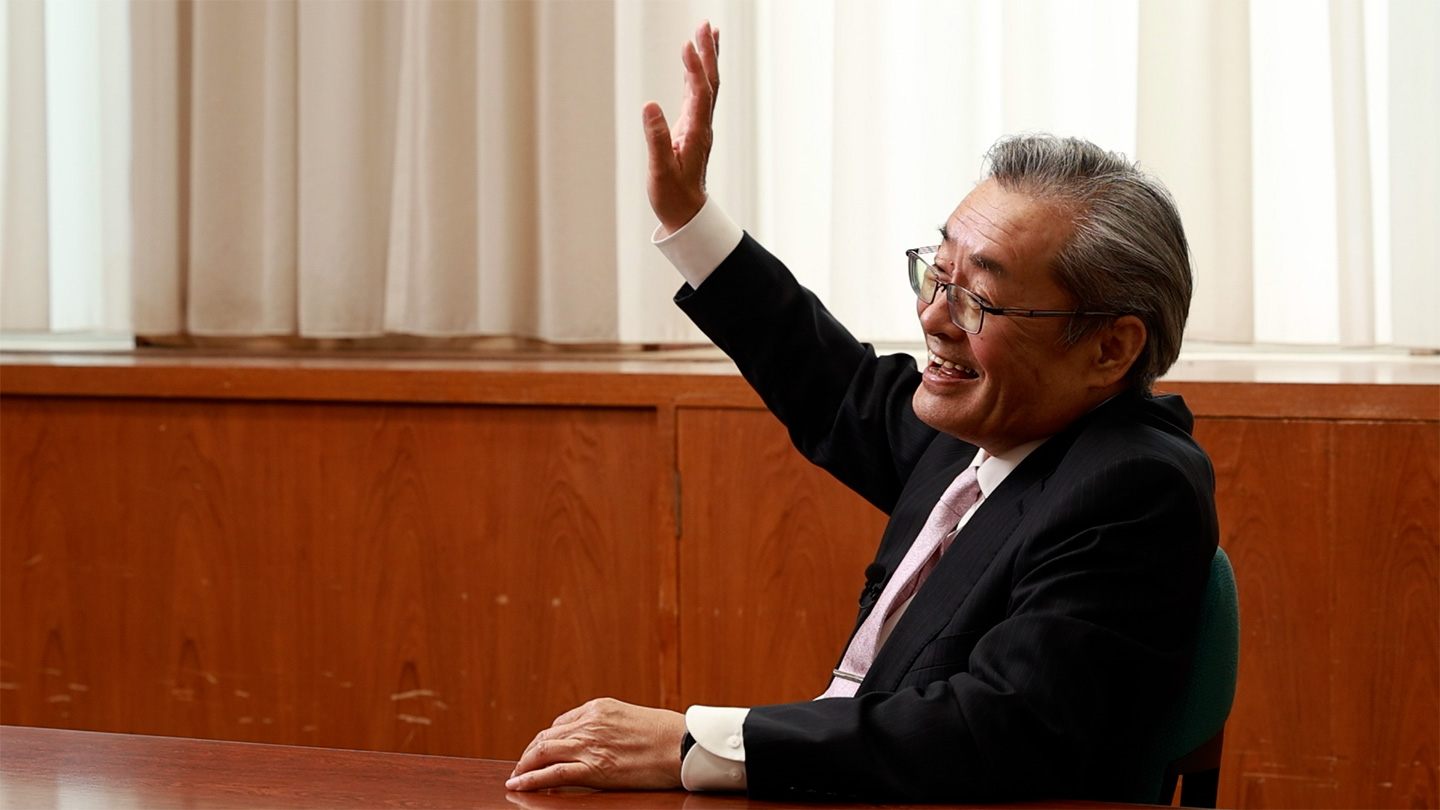Survey or Interview中川 和彦
大学、大学院を通じて、
腫瘍内科としてのアイデンティティを
持っていることが近大の強み
Kindai Medical Oncology— From University to Graduate School, guided by purpose, driven by excellence.
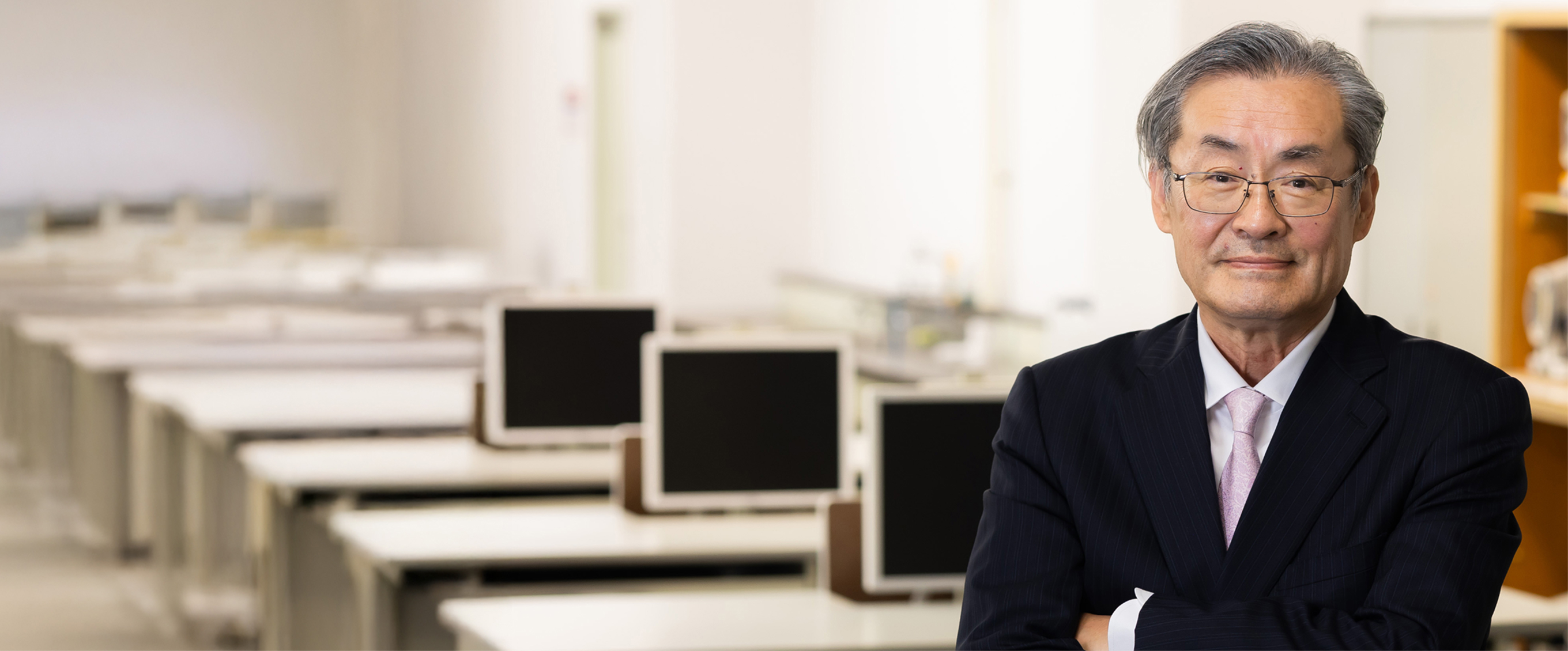
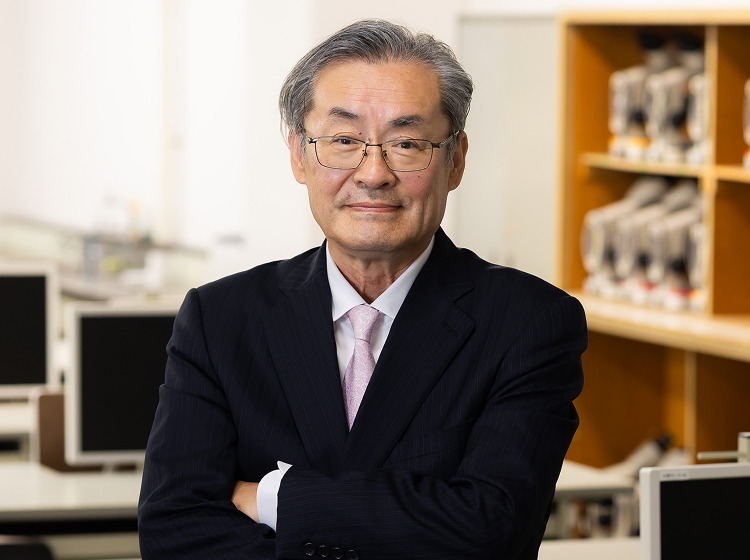
中川 和彦
Interview
NAKAGAWA Kazuhiko
がんセンター特任教授
Specially Appointed Professor of Cancer Center
1984年、熊本大学医学部附属病院の第一内科の研修医となった中川和彦が最初に担当したのは肺がんの患者だった。
「まだ30代の若い男性でした。Ⅲ期に入っておりリンパ節にまで転移していました。当時のがん治療は手術しかなく、外科に送ることになりました」
外科手術とは、がんになった部分、その周囲の組織を切除することだ。がんが転移している場合は、根治治療にはならない。
「数か月後、遠隔転移が認められ第一内科に戻ってこられたんです。そこでぼくはシスプラチンという抗がん剤を使うことにしました」
シスプラチンは細胞障害性抗悪性腫瘍薬の1つである。簡単に言えば、がん細胞のDNAを壊す、抗がん剤だ。
「当時はがんの薬物療法はほとんど注目されていなかった時代でした。シスプラチンがようやく日本で使えるようになりました。ただ、第一内科では誰も使ったことがなかったんです。ぼくは研修医でありながら、使いたいと思って製薬会社から資料を取り寄せて、投与しました」
シスプラチンは強力な効果がある一方、副作用がある。
「腎臓が壊れてしまう可能性がありました。そこで1日に2、3リットルの水分を点滴するんです」
なにせ初めてでしたから、非常にビクビクしながらやったことを覚えていますと中川は振り返る。とにかく目の前の患者を助けたいという一念だった。
その後、中川は八千代労災病院を経て、85年に国立医療所熊本南病院に移った。
ある日、熊本大学医学部附属病院へすぐに来るようにという電話が入った。
「その患者さんが亡くなったんです。病院側が遺体解剖をお願いしたところ、奥様がぼくが立ち合うことが条件だとおっしゃった」
新しい治療法に関する研究に役立てる目的の病理解剖だった。
中川は、急いで病院に向かうと、解剖室で小さな女の子の手を握った女性がぼう然と立っていた。彼女は中川の顔を見ると泣きながら抱きついてきた。
「ぼくが彼のことを考えて一生懸命やっていたことを奥様が認めてくれたことは嬉しかった。でもぼくが何もできなかったのも事実。自分の無力を痛感しました」
翌86年、中川は、東京都中央区築地にある国立がんセンター(現・国立がんセ研究センター研究所)への国内留学を志願する。
国立がんセンターは、1962年設立。日本のがん対策の中核機関として臨床部門の中央病院と基礎研究分門の研究所を併設していた。そのがんセンターがクリニカルレジデント(臨床研究医)を募集していたのだ。
しかし——。
「ぼくはね、試験受けるとだいたい落ちるんですよ」と笑う。
「落ちて、非常に落胆していたんです。そうしたら、がんセンターの偉い人から電話がありました。クリニカルレジデントでは落ちたけれど、リサーチレジデントとして来ないかというお誘いでした」
リサーチレジデントとは、研究に主軸を置いて活動する若手医師や医療従事者の意だ。
長らく日本人の死因の1位は結核だった。その後、薬品、衛生環境改善等で結核は激減。脳血管疾患——脳卒中が死因の1位になった。80年代に入り、がんが脳卒中を抜いて1位になっている。がんの治療成績を上げることを国は重視していたのだ。
「臨床医だけじゃなく、新しい治療法を開発できる、基礎医学に精通した医師を育成するという意図があったんでしょう。ぼくは、がんセンターで新しい抗がん剤治療を学ぶつもりでしたが、そうでない方向に進むことになった。結果的にはそれが良かったんです」
やむを得なく選んだ道が、中川の天職となる。
「まだ30代の若い男性でした。Ⅲ期に入っておりリンパ節にまで転移していました。当時のがん治療は手術しかなく、外科に送ることになりました」
外科手術とは、がんになった部分、その周囲の組織を切除することだ。がんが転移している場合は、根治治療にはならない。
「数か月後、遠隔転移が認められ第一内科に戻ってこられたんです。そこでぼくはシスプラチンという抗がん剤を使うことにしました」
シスプラチンは細胞障害性抗悪性腫瘍薬の1つである。簡単に言えば、がん細胞のDNAを壊す、抗がん剤だ。
「当時はがんの薬物療法はほとんど注目されていなかった時代でした。シスプラチンがようやく日本で使えるようになりました。ただ、第一内科では誰も使ったことがなかったんです。ぼくは研修医でありながら、使いたいと思って製薬会社から資料を取り寄せて、投与しました」
シスプラチンは強力な効果がある一方、副作用がある。
「腎臓が壊れてしまう可能性がありました。そこで1日に2、3リットルの水分を点滴するんです」
なにせ初めてでしたから、非常にビクビクしながらやったことを覚えていますと中川は振り返る。とにかく目の前の患者を助けたいという一念だった。
その後、中川は八千代労災病院を経て、85年に国立医療所熊本南病院に移った。
ある日、熊本大学医学部附属病院へすぐに来るようにという電話が入った。
「その患者さんが亡くなったんです。病院側が遺体解剖をお願いしたところ、奥様がぼくが立ち合うことが条件だとおっしゃった」
新しい治療法に関する研究に役立てる目的の病理解剖だった。
中川は、急いで病院に向かうと、解剖室で小さな女の子の手を握った女性がぼう然と立っていた。彼女は中川の顔を見ると泣きながら抱きついてきた。
「ぼくが彼のことを考えて一生懸命やっていたことを奥様が認めてくれたことは嬉しかった。でもぼくが何もできなかったのも事実。自分の無力を痛感しました」
翌86年、中川は、東京都中央区築地にある国立がんセンター(現・国立がんセ研究センター研究所)への国内留学を志願する。
国立がんセンターは、1962年設立。日本のがん対策の中核機関として臨床部門の中央病院と基礎研究分門の研究所を併設していた。そのがんセンターがクリニカルレジデント(臨床研究医)を募集していたのだ。
しかし——。
「ぼくはね、試験受けるとだいたい落ちるんですよ」と笑う。
「落ちて、非常に落胆していたんです。そうしたら、がんセンターの偉い人から電話がありました。クリニカルレジデントでは落ちたけれど、リサーチレジデントとして来ないかというお誘いでした」
リサーチレジデントとは、研究に主軸を置いて活動する若手医師や医療従事者の意だ。
長らく日本人の死因の1位は結核だった。その後、薬品、衛生環境改善等で結核は激減。脳血管疾患——脳卒中が死因の1位になった。80年代に入り、がんが脳卒中を抜いて1位になっている。がんの治療成績を上げることを国は重視していたのだ。
「臨床医だけじゃなく、新しい治療法を開発できる、基礎医学に精通した医師を育成するという意図があったんでしょう。ぼくは、がんセンターで新しい抗がん剤治療を学ぶつもりでしたが、そうでない方向に進むことになった。結果的にはそれが良かったんです」
やむを得なく選んだ道が、中川の天職となる。
The greatest strength of Kindai University lies in the identity of having studied medical oncology in both the Faculty of Medicine and the Graduate School.
In 1984, NAKAGAWA Kazuhiko began his residency in the First Department of Internal Medicine at Kumamoto University Hospital. The very first patient entrusted to him was a man with lung cancer.“He was still in his thirties, a young man. The cancer was already at stage III and had spread to his lymph nodes. At that time, surgery was the only recognized treatment, so we referred him to the surgeons,” NAKAGAWA recalls.
Surgery meant cutting out the cancerous area along with the surrounding tissue. But if the cancer had metastasized, such an operation could not be curative.
“A few months later, distant metastases were detected, and he was sent back to our department. That was when I decided to use an anticancer drug called cisplatin,” he recalls.
Cisplatin, a cytotoxic antineoplastic agent, is—put simply—an anticancer drug that destroys the DNA of cancer cells.
“At the time, drug therapy for cancer drew almost no attention. Cisplatin had only just become available in Japan. In the First Department of Internal Medicine, no one had ever used it. Even though I was just an intern, I wanted to try it. I ordered the data from the pharmaceutical company and administered it myself.”
Cisplatin was undeniably powerful, but it came with heavy side effects.
“It can damage the kidneys, so we had to intravenously give the patient two to three liters of fluids per day,” NAKAGAWA says.
Because it was the first time he had ever used the drug, NAKAGAWA admits he had been extremely nervous, almost trembling with caution. Yet at the core was only one thought: the desperate wish to save the patient standing before him.
After a stint at Yatsushiro Rosai Hospital, NAKAGAWA moved in 1985 to Kumamoto Minami National Hospital. One day, a phone call came from Kumamoto University Hospital, summoning him immediately.
“That patient had passed away. When the hospital had requested a pathological autopsy for research into new treatments, his wife insisted that I be present as a condition,” he explains.
Hurrying to the hospital, NAKAGAWA entered the autopsy room, where a woman stood in stunned silence, clutching the hand of a small girl. The moment she saw NAKAGAWA’s face, she broke into tears and threw her arms around him.
“It touched me deeply that his wife recognized how hard I had fought for her husband. But, the truth was, I hadn’t been able to save him. I felt utterly powerless,” he says.
The following year, in 1986, NAKAGAWA resolved to apply for a domestic fellowship at the National Cancer Center in Tsukiji, Tokyo.
Founded in 1962, the National Cancer Center had become Japan’s core cancer institution, comprising both the Central Hospital for clinical care and the Research Institute for basic science. At that time, the center was recruiting Clinical Residents, or Clinical Fellows.
But—
“You know, I usually fail exams,” NAKAGAWA says with a laugh.
“And when I failed this one, I was deeply discouraged. Then I got a call from a senior figure at the Cancer Center. He told me I hadn’t made it as a Clinical Resident but asked if I would come as a Research Resident instead.”
A Research Resident meant a young physician or medical professional who focuses primarily on research rather than on daily clinical duties.
For many years, the leading cause of death in Japan had been tuberculosis. But with the advent of antibiotics and improvements in public hygiene, tuberculosis had plummeted. Stroke then took over as the number one killer—until the 1980s, when cancer surpassed it. The Japanese government had begun to place national priority on improving cancer treatment outcomes.
“I think the idea was not just to train clinicians, but also doctors well-versed in basic science who could develop new treatments. I had originally intended to go to the Cancer Center to learn about new anticancer drug therapies, but I ended up heading in a different direction. In the end, that turned out to be the best thing for me,” NAKAGAWA reflects.
The road he had taken almost reluctantly would, in time, become NAKAGAWA’s true calling—his vocation.
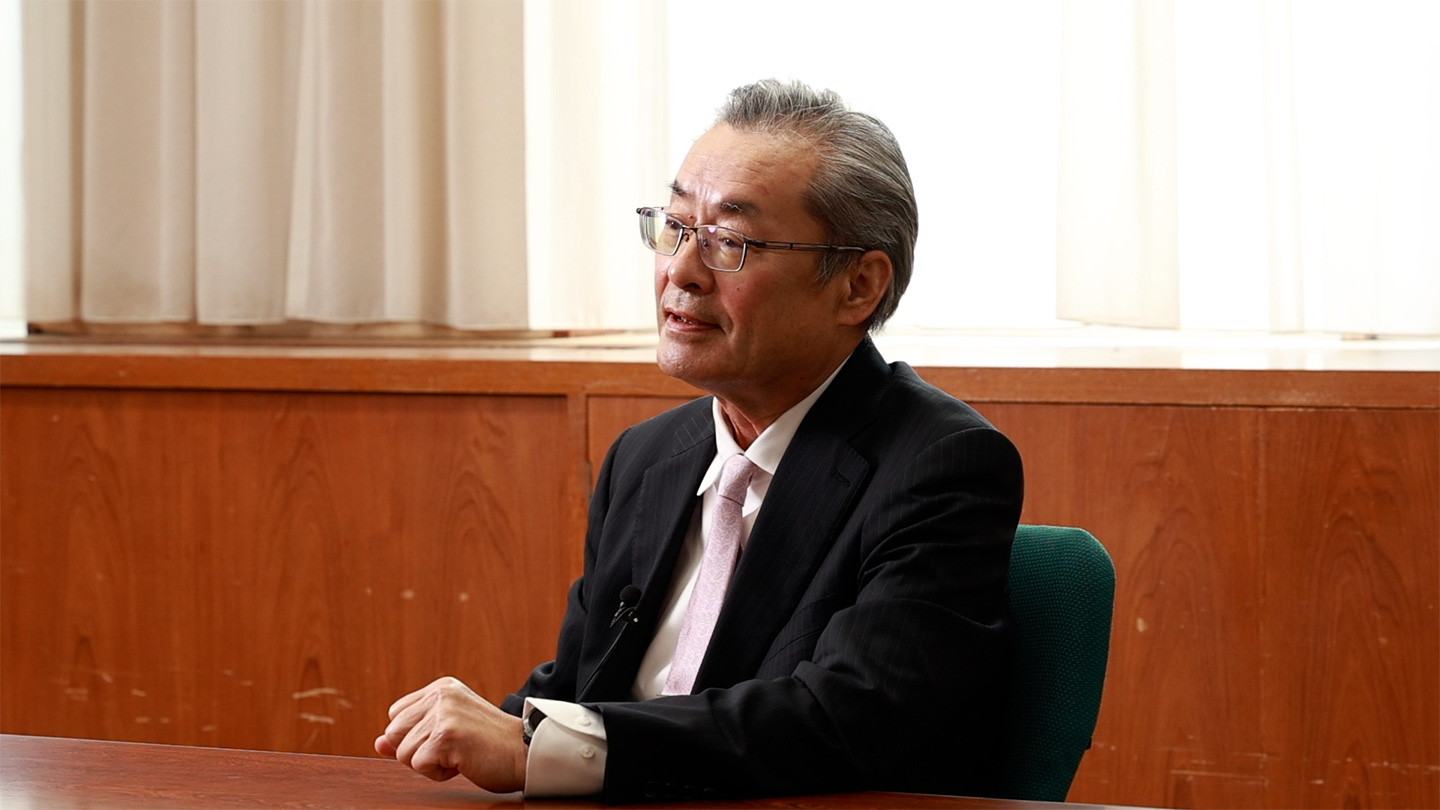
中川は1957年に熊本県鹿本郡鹿本町(現・山鹿市)で生まれた。上に2人の姉がいる。生後50日後に交通事故で父親を失い、母親が養鶏組合で働きながら3人を育てた。
「良く、トリさんのお陰で大きくなったと言うんです」と笑う。
鹿本町は熊本県北部の内陸部、山に囲まれた盆地で自然に恵まれていた。
「子どもの頃は落ち着きがなくて、しょっちゅう鞄や学生服など忘れ物してましたね」
医師を志したのは高校生のときだ。
「明確に医者になりたいという強い願望があったわけではないんですが、人と関わり合いがある職業があるということで、学校の先生と医師がいいかなと思ったんです」
しかし、最初に入学したのは工学部だった。
「私の学力では医学部は難しいということで機械工学科を受験したんです。合格して通ってみたけどなんか釈然としない。それで浪人することにしました」
うちは母子家庭で、そんなに裕福ではない。本当に我が儘だったんですねと頭を掻く。
「一浪でも不合格。二浪で合格することができました」
77年、熊本大学医学部に入学した。
「もともとはプライマリーケア(一次医療)を担える町医者を目指していました。色々な疾患を診ることができる第一内科を選びました」
そこで、肺がんの患者と出会い、国立がんセンター研究所薬効試験部に入ったことは前述した。
「最初は研究をしていく、なんて考えたこともなかったんです」
国立がんセンターで主に注力したのは、抗がん剤の〝耐性克服〟の研究だった。
「当時の抗がん剤は、がん細胞が正常細胞よりも早く分裂することを利用して優先的に殺していく〝細胞障害性抗がん薬〟でした。しかし、一旦効いたとしてもすぐに効かなくなる。これを耐性と言います。このメカニズムを研究してずっと効くようにできれば、がんという病気を制御できるのではないかという発想です」
「良く、トリさんのお陰で大きくなったと言うんです」と笑う。
鹿本町は熊本県北部の内陸部、山に囲まれた盆地で自然に恵まれていた。
「子どもの頃は落ち着きがなくて、しょっちゅう鞄や学生服など忘れ物してましたね」
医師を志したのは高校生のときだ。
「明確に医者になりたいという強い願望があったわけではないんですが、人と関わり合いがある職業があるということで、学校の先生と医師がいいかなと思ったんです」
しかし、最初に入学したのは工学部だった。
「私の学力では医学部は難しいということで機械工学科を受験したんです。合格して通ってみたけどなんか釈然としない。それで浪人することにしました」
うちは母子家庭で、そんなに裕福ではない。本当に我が儘だったんですねと頭を掻く。
「一浪でも不合格。二浪で合格することができました」
77年、熊本大学医学部に入学した。
「もともとはプライマリーケア(一次医療)を担える町医者を目指していました。色々な疾患を診ることができる第一内科を選びました」
そこで、肺がんの患者と出会い、国立がんセンター研究所薬効試験部に入ったことは前述した。
「最初は研究をしていく、なんて考えたこともなかったんです」
国立がんセンターで主に注力したのは、抗がん剤の〝耐性克服〟の研究だった。
「当時の抗がん剤は、がん細胞が正常細胞よりも早く分裂することを利用して優先的に殺していく〝細胞障害性抗がん薬〟でした。しかし、一旦効いたとしてもすぐに効かなくなる。これを耐性と言います。このメカニズムを研究してずっと効くようにできれば、がんという病気を制御できるのではないかという発想です」
At the U.S. National Cancer Institute, there were no boundaries between clinical departments.
NAKAGAWA Kazuhiko was born in 1957 in the rural town of Kamoto, Kamoto District, Kumamoto Prefecture (present-day Yamaga City). He was the youngest of three children, with two elder sisters. Just fifty days after his birth, tragedy struck—his father died in a traffic accident. His mother raised the three siblings alone, working at a poultry cooperative to make ends meet.“I often say I grew up thanks to the chickens,” he says with a smile.
Kamoto was a basin town surrounded by the mountains of northern Kumamoto, an area rich in natural beauty.
“As a child, I was restless. I was always forgetting things—my school bag, my uniform, you name it,” he admitted.
It was during high school that he first thought of becoming a doctor.
“It wasn’t a strong ambition to be a physician specifically, but I wanted a job that involved working with people. I thought maybe a schoolteacher or a doctor would be good options.”
Yet his first step was not into medicine, but engineering.
“I didn’t think my grades were good enough for medical school, so I applied to mechanical engineering. I passed the exam and enrolled, but it never sat right with me. So, I decided to take a year off and try again.”
It was not an easy choice. Growing up in a single-parent household, the family was far from wealthy. “Honestly, I was being selfish,” he admits, scratching his head.
“I failed again on my first retry, but on the second I finally passed.”
In 1977, NAKAGAWA entered the Faculty of Medicine at Kumamoto University.
“At first, my goal was to become a town doctor, someone who could provide primary care. That’s why I chose the First Department of Internal Medicine, where you could see all kinds of diseases.”
It was there that he first encountered a patient with lung cancer, an experience that eventually led him to the National Cancer Center Research Institute’s Division of Experimental Chemotherapy.
“At first, I never even imagined that I would end up doing research,” he recalls.
At the National Cancer Center, his primary focus became research into how to overcome cancer drug resistance.
“The anticancer drugs of that time were cytotoxic agents, designed to preferentially kill cancer cells by exploiting their faster rate of division compared to normal cells. But even if the drugs worked at first, they quickly stopped being effective. That phenomenon is what we call drug resistance. Our thinking was that if we could study the mechanisms behind this and find a way to keep the drugs working, we might be able to truly control cancer as a disease.”
In 1987, after serving as a senior resident in internal medicine at the National Cancer Center Hospital, NAKAGAWA moved in 1990 to the Second Department of Internal Medicine at Habikino Hospital in Osaka Prefecture.
“At that time, Habikino Hospital was called the ‘Cancer Center of the West’ for lung cancer treatment. We saw an incredible number of lung cancer patients. I also took part in the predecessor of today’s JCOG (the Japan Clinical Oncology Group), conducting nationwide clinical trials and the rare early-stage drug studies that existed in Japan at the time.”
In 1994, NAKAGAWA went abroad to study at the National Cancer Institute (NCI), part of the U.S. National Institutes of Health (NIH) in Maryland. The NCI was, and remains, one of the world’s foremost centers for cancer research.
What struck NAKAGAWA most in America was the absence of rigid boundaries between medical specialties.
“I had focused exclusively on lung cancer in my research. My supervisor, Dr. Michael Kelley, also specialized in lung cancer, but he studied other cancer types as well. In his lab, there were people researching blood cancers, pancreatic cancer, and many other malignancies. I, too, began to look beyond lung cancer and study cancer as a whole.”
He smiles softly. “And I found that was fun, too.”
“Lung cancer is actually quite different from other respiratory diseases such as emphysema or asthma. On the other hand, when it comes to tumors, it is very close to gastric cancer and other malignancies. What researchers are discovering in those cancers often applies to lung cancer as well.”
At the NCI, NAKAGAWA was also involved in the basic research that would later lead to the development of molecular targeted therapies. That experience—participating in the very process of drug discovery—became a tremendous asset for him.
In July 1997, at the invitation of FUKUOKA Masahiro, his former supervisor from the Habikino Hospital days, NAKAGAWA returned to Japan and joined the Fourth Department of Internal Medicine at Kindai University Faculty of Medicine.
“I thought that if I went to work under Professor Fukuoka, I would surely be able to continue my research in cancer.”
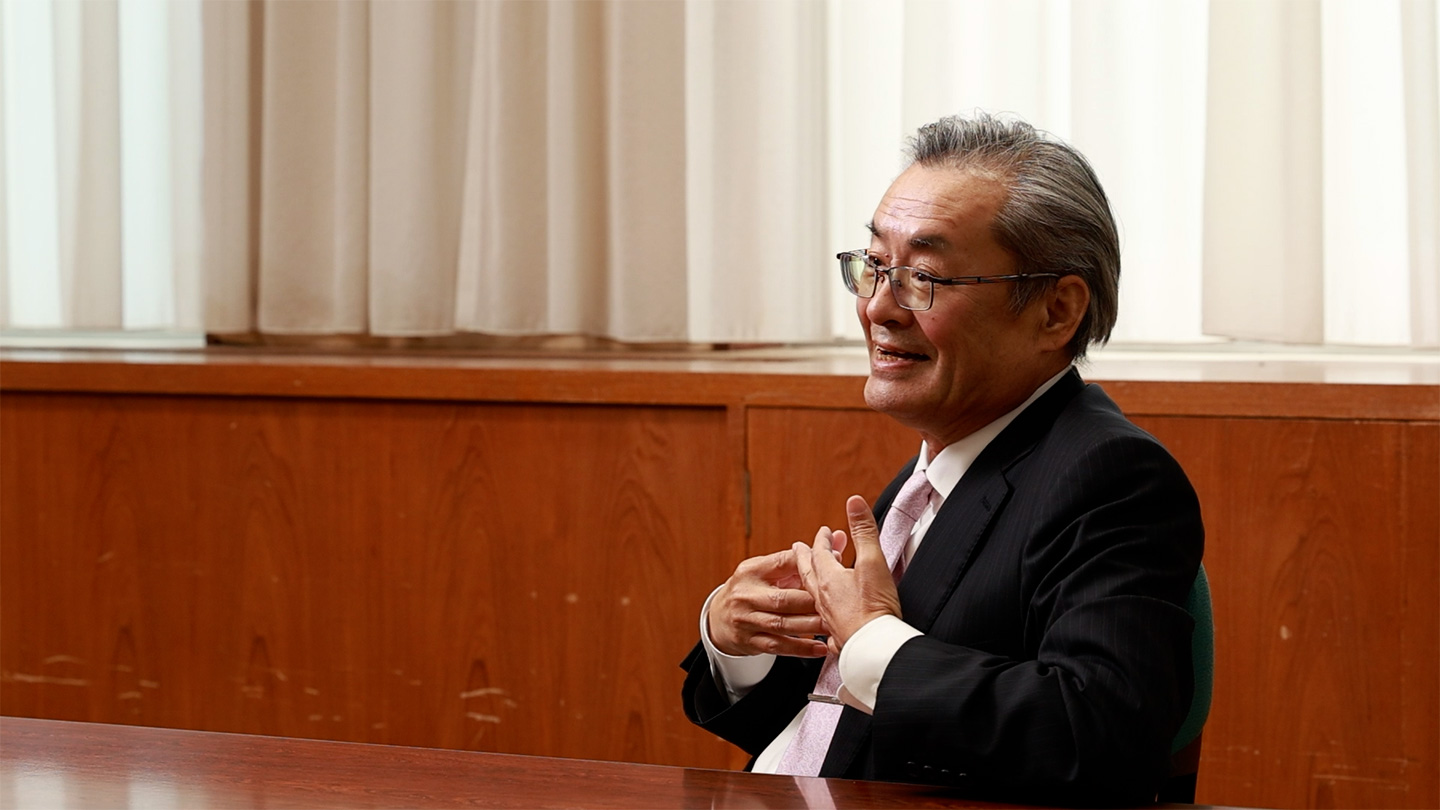
87年に国立がんセンター中央病院内科のシニアレジデントを経て、90年に大阪府羽曳野病院第二内科に移る。
「当時の羽曳野病院は、肺がんの臨床においては〝西のがんセンター〟と呼ばれて、ものすごい数の肺がん患者が集まっていた。今のJCOG(日本臨床腫瘍研究グループ)の前身の組織にも参加して、全国的な臨床試験、まだ少なかったんですが新薬の治験も行っていたんです」
そして94年、アメリカのメリーランド州にある国立衛生研究所(NIH)の国立がん研究所(NCI)に留学する。NCIは、世界屈指のがん研究機関である。
中川がアメリカで目の当たりにしたのは、診療科の垣根がなかったことだった。
「ぼくは肺がんに特化して研究してきました。ぼくの上司であるマイケル・ケリー先生は肺がんをメインにしていましたが、他のがん種も見ていました。彼のラボ(研究室)には血液のがん、膵臓がんなど様々な研究をしている人間が集まっていた。ぼくも肺がんという枠を抜け出し、がん領域全体を見渡して研究するようになった」
それも楽しかったんですよと微笑む。
「肺がんは、肺気腫、喘息といった肺の呼吸器疾患と距離がある。一方、胃癌などの他のがん種とは、腫瘍という意味で非常に近いんです。他のがんで研究している内容が、肺がんの領域にも通じることが多々ある」
NCIでは、後に分子標的薬となる基礎研究にも携わった。創薬に関わったことは中川の大きな力となった。
97年7月、中川は羽曳野病院時代の上司であった福岡正博の誘いで、日本に帰国して近畿大学医学部第4内科に入った。
「福岡先生の元に行けば、がんの研究ができるだろうと考えていました」
福岡との思い出で最も印象に残っているのは、腫瘍内科立ち上げである。
「福岡先生は近畿大学でがんの治療、研究をどう進めていくのかを考えておられた。当時の学長だった野田起一郎先生が福岡先生に、腫瘍内科か、がんセンターのどちらを先に設置するかという話をされたんでしょう。福岡先生が私に意見を求められたことがありました」
NCIの経験があった中川は「がんを臓器を越えて診る腫瘍内科だと思います。絶対に腫瘍内科を作ってください」と即答した。2002年4月、医学部に腫瘍内科が開設。中川は2003年に腫瘍内科の助教授、そして2007年に福岡の後を継いで2代目の腫瘍内科教授に就任した。
腫瘍内科から遅れること7年、2009年には近畿大学病院内に、がんセンターが設立されている。がんは、近畿大学医学部、近畿大学病院が最も力を入れる柱である。
中川が近畿大学の鍵は、医学部に加えて大学院に腫瘍内科コースがあることだと考えている。
「大学院には、近畿大学医学部の卒業生の他、他大学からやってきて、研究や臨床を行っています。そこで診療科別の専門領域だけでなく、オールラウンドに勉強して、腫瘍内科医として育つ。彼ら、彼女たちは自分たちは腫瘍内科学をやっているという自己同一性(アイデンティティ)を持っている。そうした人がここに残る、あるいは全国に散らばって行っているんです」
2025年秋、近畿大学医学部と附属病院は慣れ親しんだ大阪狭山市から堺市に移転する。新キャンパス移転と新病院は、腫瘍内科がもう一段、階段を上るきっかけになると中川は言う。
「これまでは物理的に離れた場所にあった、がん相談支援センター、緩和ケアセンター、通院治療センター、そしてがんの診療をしている外来ブースが1カ所に集まる。バーチャルの繋がりから、空間的に集約される」
近畿大学病院の腫瘍内科とがんセンターは、もう一歩、階段を上がることになる。
「当時の羽曳野病院は、肺がんの臨床においては〝西のがんセンター〟と呼ばれて、ものすごい数の肺がん患者が集まっていた。今のJCOG(日本臨床腫瘍研究グループ)の前身の組織にも参加して、全国的な臨床試験、まだ少なかったんですが新薬の治験も行っていたんです」
そして94年、アメリカのメリーランド州にある国立衛生研究所(NIH)の国立がん研究所(NCI)に留学する。NCIは、世界屈指のがん研究機関である。
中川がアメリカで目の当たりにしたのは、診療科の垣根がなかったことだった。
「ぼくは肺がんに特化して研究してきました。ぼくの上司であるマイケル・ケリー先生は肺がんをメインにしていましたが、他のがん種も見ていました。彼のラボ(研究室)には血液のがん、膵臓がんなど様々な研究をしている人間が集まっていた。ぼくも肺がんという枠を抜け出し、がん領域全体を見渡して研究するようになった」
それも楽しかったんですよと微笑む。
「肺がんは、肺気腫、喘息といった肺の呼吸器疾患と距離がある。一方、胃癌などの他のがん種とは、腫瘍という意味で非常に近いんです。他のがんで研究している内容が、肺がんの領域にも通じることが多々ある」
NCIでは、後に分子標的薬となる基礎研究にも携わった。創薬に関わったことは中川の大きな力となった。
97年7月、中川は羽曳野病院時代の上司であった福岡正博の誘いで、日本に帰国して近畿大学医学部第4内科に入った。
「福岡先生の元に行けば、がんの研究ができるだろうと考えていました」
福岡との思い出で最も印象に残っているのは、腫瘍内科立ち上げである。
「福岡先生は近畿大学でがんの治療、研究をどう進めていくのかを考えておられた。当時の学長だった野田起一郎先生が福岡先生に、腫瘍内科か、がんセンターのどちらを先に設置するかという話をされたんでしょう。福岡先生が私に意見を求められたことがありました」
NCIの経験があった中川は「がんを臓器を越えて診る腫瘍内科だと思います。絶対に腫瘍内科を作ってください」と即答した。2002年4月、医学部に腫瘍内科が開設。中川は2003年に腫瘍内科の助教授、そして2007年に福岡の後を継いで2代目の腫瘍内科教授に就任した。
腫瘍内科から遅れること7年、2009年には近畿大学病院内に、がんセンターが設立されている。がんは、近畿大学医学部、近畿大学病院が最も力を入れる柱である。
中川が近畿大学の鍵は、医学部に加えて大学院に腫瘍内科コースがあることだと考えている。
「大学院には、近畿大学医学部の卒業生の他、他大学からやってきて、研究や臨床を行っています。そこで診療科別の専門領域だけでなく、オールラウンドに勉強して、腫瘍内科医として育つ。彼ら、彼女たちは自分たちは腫瘍内科学をやっているという自己同一性(アイデンティティ)を持っている。そうした人がここに残る、あるいは全国に散らばって行っているんです」
2025年秋、近畿大学医学部と附属病院は慣れ親しんだ大阪狭山市から堺市に移転する。新キャンパス移転と新病院は、腫瘍内科がもう一段、階段を上るきっかけになると中川は言う。
「これまでは物理的に離れた場所にあった、がん相談支援センター、緩和ケアセンター、通院治療センター、そしてがんの診療をしている外来ブースが1カ所に集まる。バーチャルの繋がりから、空間的に集約される」
近畿大学病院の腫瘍内科とがんセンターは、もう一歩、階段を上がることになる。
Kindai University’s strength lies in having a course in Medical Oncology both in the Faculty of Medicine and in the Graduate School.
One of NAKAGAWA’s most vivid memories of working with FUKUOKA was the founding of the Department of Medical Oncology at Kindai.“Professor Fukuoka was deeply considering how cancer treatment and research should move forward at Kindai. At that time, the university president, Professor Noda Kiichiro, had apparently asked him whether it would be better to first establish a Department of Medical Oncology or a Cancer Center. Professor Fukuoka even asked for my opinion,” NAKAGAWA recalls.
Drawing on his experience at the NCI, NAKAGAWA answered without hesitation:
“It should be medical oncology—an oncology department that can treat cancer across organ boundaries. Please, absolutely make it happen.”
And so, in April 2002, Kindai University Faculty of Medicine formally opened its Department of Medical Oncology. In 2003, NAKAGAWA became an Associate Professor in the new department, and in 2007, he succeeded FUKUOKA as the second Professor of Medical Oncology.
Seven years after the Department of Medical Oncology was established, in 2009, the Cancer Center was founded within Kindai University Hospital. Cancer had become one of the central pillars of Kindai University Faculty of Medicine and its affiliated hospital.
NAKAGAWA believes the true strength of Kindai University lies in having not only the undergraduate medical program but also a graduate course in medical oncology.
“Our graduate school draws not only alumni of Kindai University Faculty of Medicine but also students from other universities who come here to train in both research and clinical practice. They don’t just study narrow specialties by organ—they learn broadly and develop their identity as medical oncologists. Some stay here, and others go on to work all over Japan,” he explains.
In the fall of 2025, the Faculty of Medicine and its affiliated hospital will relocate from their longtime home in Osaka-Sayama to the new campus in Sakai City. NAKAGAWA believes this relocation, and the opening of the new hospital, will become the catalyst for the Department of Medical Oncology to rise to the next level.
“Until now, facilities such as the Cancer Counseling and Support Center, the Palliative Care Center, the Outpatient Chemotherapy Center, and outpatient oncology clinics have all been scattered in separate physical spaces. With the move, they will finally be brought together in one place. What was once connected only virtually will become physically integrated,” he says.
With this transformation, Kindai University Hospital’s Department of Medical Oncology and the Cancer Center are poised to take another decisive step forward.
